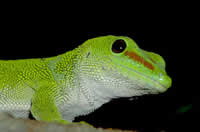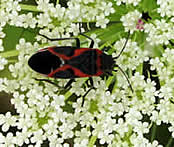USDA Forest Service Celebrating Wildflowers
|
|
|
Unusual PollinationThere are many different kinds of pollinators. Of these, the animals that can fly are generally the best at transferring pollen. Flying insects are the most common pollinators. In addition to butterflies, bees and moths, many species of beetles, and flies are important pollinators. However, there are many animals, large and small, that are critical in pollinating flowers. Large PollinatorsOn the island of Madagascar, black and white ruffed lemurs are the main pollinators of traveler’s trees or traveler’s palm. These trees are typically 40-feet-high. They lemurs use their nimble hands to pull open the tough flower bracts. They stick their long snouts and tongues deep inside a tree's flower. As a result, they collect pollen on their muzzle and fur, and then transport it to the next flower. The resulting fruits are a major source of food. It appears that no other creature has the strength and nimbleness to pollinate the palm. This gives the black and white ruffed lemur the award of the world’s largest pollinator! Fun FactWhat is a lemur and what does the word "lemur" mean? A lemur is a type of prosimian primate that is only found in the wild on the island of Madagascar. Lemur in Latin means "ghost". Many of the Malagasy people believe lemurs are similar to spirits or ghosts because of their haunting stare and night activity. To learn more about lemurs, visit The Lemur Center of Duke University. Honey PossumsThe honey possum of Australia pollinates the flowers of banksia and eucalyptus flowers. This darling pollinator has several adaptations that make it a successful pollinator including grasping feet and a prehensile tail that allows it to hang from the branches of trees as it searches for flowers, an extremely long tongue to drink nectar, and a pointed snout that is dusted with pollen when it drinks from flowers. Many tropical bats are pollinators as well as a number of other tropical mammals, including bush babies, sugar gliders and a number of small Australian marsupials. Fun FactLizards, geckos, and skinks can be pollinators! The Noronha skink found in Brazil drink the nectar found in the flowers of the leguminous mulungu tree. This tree blooms during the dry season, and the flowers secrete nectar throughout the day. The skinks climb inside the flower to drink the nectar. While foraging for nectar, parts of the skink’s body contact the anthers and stigmas and pollen adheres to their scales. As these “little dragons” visit other flowers from the same tree and other trees it deposits pollen and becomes a potential pollinator. To learn more about this fascinating pollinator, read about Little dragons prefer flowers to maidens: a lizard that laps nectar and pollinates trees (PDF). In New Zealand, there is a gecko that pollinates flax flower. Small PollinatorsSlugs, gnats, and true bugs (Hemiptera) are also pollinators. |
|
| Ants | Bats | Bees | Beetles | Birds | Butterflies | Flies | Moths | Unusual | Wasps | Wind & Water | |
| NOTE: PDF format links require the Adobe Acrobat Reader to view. | |
| top | Disclaimers | FOIA | Privacy Policy | Quality of Information | Photo Credits & Use |
Location: http://www.fs.fed.us/wildflowers/pollinators/unusual.shtml
Last modified: Tuesday, 20-May-2008 15:56:21 EDT







